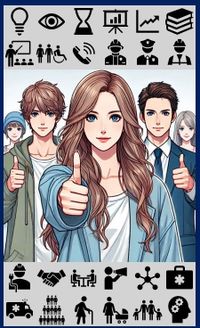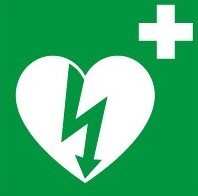More creative scenarios for the club of little and big heroes
1. Rescue in the Park 🌳
Scenario 🎬: A doll has become unconscious while playing in the park. During cardiac arrest, there is usually no warning and one collapses suddenly. Often, first responders are afraid of doing something wrong in this moment, and as a result, they hesitate to start the necessary life-saving resuscitation measures before the emergency services arrive. BUT always remember that immediate resuscitation measures can at least double the chances of survival for the affected person. Even our little heroes can provide valuable life-saving help here, as early emergency calls, correct behavior, and the use of a defibrillator can be crucial.
Activities: Recognizing symptoms such as unconsciousness and lack of response.
Measures
- Always ensure self-protection!
- Speak to and shake the person!
- If there is no response, immediately call for help (mom, dad, or another adult), call the emergency services, check for signs of life.
- Is breathing normal?
- Get to know the defibrillator symbol and understand that a life-saving defibrillator can be found there.
- Develop an understanding that a defibrillator does not replace chest compressions.
Lesson content: First aid measures in case of unconsciousness and the importance of staying calm.
2. Emergency in the Kitchen 🍳
Scenario 🎬: While cooking, a doll has cut its finger.
Activities: Identifying symptoms such as a bleeding wound.
Measures: Cleaning the wound, applying a pressure bandage, speaking soothingly, and calling an adult.
Lesson Content: Handling cut wounds and hygiene measures.
3. Asthma Attack in the Classroom 🏫
Scenario 🎬: A doll has an asthma attack during class.
Activities: Identifying symptoms such as wheezing and shortness of breath.
Measures: Bringing the inhaler, calming the person, and calling emergency services if necessary.
Lesson Content: Managing an asthma attack and the proper use of an inhaler.
4. Heat Exhaustion During Sports 🥵
Scenario 🎬: A doll shows signs of heat exhaustion after physical education class.
Activities: Identifying symptoms such as weakness, dizziness, and heavy sweating.
Measures: Moving to the shade, giving water, placing a damp cloth on the forehead, and speaking soothingly.
Lesson Content: Recognizing and responding to heat exhaustion.
5. Accident on the Playground 🎠
Scenario 🎬: A doll has fallen from the climbing frame and broken its leg.
Activities: Identifying symptoms such as pain and an unnatural position of the leg.
Measures: Staying calm, calling emergency services, stabilizing the injured area, and speaking soothingly.
Lesson Content: Handling fractures and stabilizing injuries.
6. Heart Attack ❤️🩹
Scenario 🎬: A doll shows signs of a heart attack.
Activities: Identifying symptoms such as chest pain, shortness of breath, and cold sweat.
Measures: Calling emergency services, calming the person, and placing them in a comfortable position.
Lesson Content: Recognizing a heart attack and the importance of quick action.
7. Drowning in the Lake and Rivers 🌊
Scenario 🎬: A doll is in trouble in a lake and is at risk of drowning. As you all know, most drowning accidents happen in unsupervised waters such as lakes, rivers, and canals. We also know that many swimming classes were cancelled due to the COVID-19 pandemic. Even experienced swimmers sometimes underestimate the dynamic and powerful forces of the water and overestimate their abilities. Any of us can unexpectedly get caught in currents, misjudge the distance of a swim, or simply experience a muscle cramp. It doesn't take long for us to run out of energy and strength in the water.
Activities: Identifying symptoms such as panicked movements in the water and going under, muscle cramp while swimming. Measures: If you have a muscle cramp in the water, remain calm and try to swim to the shore. If reaching the shore is not possible, attempt to alleviate the cramp while in the water.
Rescue Ranger 🚒 to the rescue immediately: If you have a cramp in your leg, turn onto your back. If you have a calf cramp, pull your toes towards your body. If the cramp is in your thigh, grab your lower leg at the ankle and press it against your thigh. Should your fingers cramp, make a fist and then abruptly stretch them out until the cramp and pain subside.
You should NEVER swim or bathe in areas with currents and without lifeguards (like at beaches or public pools). But if you ever find yourself in danger, please remember: never swim against a current, as this costs a lot of strength and energy. Try to let the current carry you and slowly swim at a slight angle towards the shore. Stay calm, even if you feel like you are drifting further; this method is still the safest way to get back to land. If you have already run out of energy and are completely exhausted, try to turn onto your back and take the dead man's float position. Let yourself float with your feet and face forward. Be sure to watch out for any potential dangers such as bridges, large driftwood, stones, and rocks, and avoid them. Use your arms to help steer your body.
Seeing someone in danger, always remember the golden rule: "Your own safety comes first." Never jump into the water unprepared, as you could quickly find yourself in danger. Find a stable "position" from which you can start your rescue attempt.
What can help? A life ring, floatation aids, a rope, an air mattress, a surfboard... anything the drowning person can hold onto while you pull them to shore and save them.
What do you do if the person is too exhausted to hold onto these "rescue items"? Approach this person only from behind, to prevent them from grabbing onto you and potentially pulling you underwater as well. When pulling them out of the water, ensure their head remains above water at all times.
Remember, every second counts! Are you still on top of everything that needs to be done? No? Then let’s quickly call Rescue Ranger 🚒 into action:
- Analogous first aid rules as you already know from many other accidents.
- Stay with the person, check their vital signs, and immediately call for help.
- Ensure the person doesn’t get further hypothermia, i.e., cover them with clothing, a towel, or a blanket (avoid direct sunlight to prevent overheating).
- IIf the person is already unconscious, quickly and safely place them in the recovery position, and monitor their pulse and breathing closely until rescue arrives.
- If breathing has already stopped, immediately start resuscitation measures, i.e., ventilation and chest compressions. Note: water may already be in the airways, and under no circumstances should you try to remove the water to avoid causing further and dangerous harm.
Curriculum: Water Safety
- Only swim when you feel comfortable and healthy.
- Never overestimate your own abilities and strengths.
- Leave the water immediately if a thunderstorm occurs.
- If you are a non-swimmer, the water should only come up to your waist.
- Leave the water as soon as you start to feel cold.
- Rescue measures: Help others when they need your assistance, BUT ensure not to put yourself in danger.
- Resuscitation techniques.
8. Insect Sting and Allergic Reaction 🐝
Scenario 🎬: A doll is stung by a bee and shows an allergic reaction.
Activities: Recognizing symptoms such as swelling, shortness of breath, skin rash.
Measures: Apply an Epipen, call emergency services, reassure the person.
Curriculum: Handling allergic reactions and the correct use of an Epipen.
9. Choking on Foreign Objects 🚫
Scenario 🎬: A doll has swallowed a small object and shows choking symptoms.
Activities: Recognizing symptoms such as shortness of breath, coughing, panic.
Measures: Perform the Heimlich maneuver, call emergency services, speak reassuringly.
Curriculum: Handling choking hazards and safely applying the Heimlich maneuver.
10. Burns from Candles or Fireworks 🕯️🔥
Scenario 🎬: A doll has burned itself on a candle or firework.
Activities: Recognizing symptoms such as redness, blistering, pain.
Measures: Cool the burned area, apply a bandage, call emergency services, speak reassuringly.
Curriculum: First aid measures for burns and prevention of fire accidents.
11. Bicycle Fall 🚴♂️
Scenario 🎬: A doll has fallen off a bicycle and has abrasions and bruises.
Activities: Recognizing symptoms such as bleeding, pain, abrasions.
Measures: Clean the wound, apply a bandage or plaster, speak reassuringly.
Curriculum: Handling abrasions and bruises and safety measures for cycling.
12. Hypothermia in Cold Weather 🥶
Scenario 🎬: A doll has become hypothermic in cold weather.
Activities: Recognizing symptoms such as shivering, pale skin, bluish lips, fatigue.
Measures: Wrap the person in warm blankets, give hot drinks, call emergency services (if necessary), speak reassuringly.
Curriculum: Recognizing and handling hypothermia and the importance of protection against cold weather.
13. Nosebleed after a Fall 🩸
Scenario 🎬: A doll has a nosebleed after a fall.
Activities: Recognizing symptoms like bleeding from the nose.
Measures: Sit the person upright, tilt the head forward and gently pinch both nostrils (for a few minutes), speak reassuringly. To reduce blood pressure in the head, sit up straight or at least elevate the head and let it hang forward (!) during a nosebleed.
Curriculum: Correct measures for handling nosebleeds and what to avoid.
14. Injury from Sharp Objects 🔪
Scenario 🎬: A doll has injured itself with a sharp object.
Activities: Recognizing symptoms such as cuts, bleeding.
Measures: Stop the bleeding, apply a bandage, call emergency services, speak reassuringly.
Curriculum: First aid measures for cuts and preventing accidents around the home.
15. Heat Stroke While Playing Outside ☀️
Scenario 🎬: A doll shows severe symptoms of heat stroke after intense playing outside.
Activities: Recognizing symptoms such as confusion, hot skin, no sweating.
Measures: Move the person to shade immediately, cool them down, give water, call emergency services, speak reassuringly.
Curriculum: Differentiating between heat exhaustion and heat stroke, and the corresponding first aid measures.
16. Electric Shock from Faulty Devices ⚡
Scenario 🎬: A doll has received an electric shock from a faulty electronic device. Depending on the type and intensity of the current, the shock can lead to cardiac arrest. Common causes include electronic devices (smartphone or tablet) falling into the bathtub, damaged cables, sockets, or appliances like a toaster. Note: The longer a person is exposed to the electrical source, the more severe the injuries.
Activities: Recognizing symptoms such as unconsciousness, burns, injuries to skin, muscles, tissues, tendons, and bones, arrhythmias, sudden muscle contractions and seizures, possible bone fractures from falls following the electric shock, skin redness or burns at the contact site, pain, tingling, nausea, dizziness, numbness, muscle twitching.
Measures: Immediate action is required! First, assess the situation and turn off the power source. Keep your distance at first and check whether the affected person is still in contact with the electrical source, as there's a risk of receiving a dangerous electric shock yourself. Turn off the power! Unplug the device or turn off the circuit breaker. Now act quickly. Call emergency services (112) - depending on the extent of the injuries - and inform them that it’s an electrical accident. Immediately check for consciousness and breathing. If the person does not respond or is not breathing, begin resuscitation measures (chest compressions and mouth-to-mouth resuscitation) right away.
Forgot how to do it? 🤔
Rescue Ranger 🚒 to the rescue immediately: Place your hand about six centimeters (2.4 inches) mid-chest on the affected person and press vertically on this spot 30 times per minute. Then perform two rescue breaths. To do this, place your mouth firmly over the mouth of the affected person and give two breaths. Repeat this process until the rescue team arrives. If breathing is stable but the person is unconscious, place them in the recovery position. Even with minor complaints, i.e., a mild electric shock, you should still see a doctor, as symptoms may appear with a delay.
Curriculum: Safety when dealing with electricity and first aid measures for electric shocks.
17. Poisoning from Household Cleaners 🧴⚠️
Scenario 🎬: A doll has accidentally ingested household cleaner.
Activities: Recognizing symptoms such as nausea, vomiting, abdominal pain.
Measures: Stay calm, carefully open the mouth of the affected person and try to remove any residue of the substance, give a small amount of water or tea to drink. Caution: no carbonated drinks! Be sure to ensure the person does not induce vomiting while drinking, as the caustic substance will pass through the esophagus again and cause additional damage, call the Poison Control Center, provide data/names of the cleaner (see packaging). You will then receive further instructions from Poison Control, speak reassuringly. If you are driving to the doctor yourself, do not forget the packaging of the ingested substance.
Curriculum: Handling poisonings and the importance of safety measures at home.
18. Injury During Sports ⚽
Scenario 🎬: A doll has sprained its wrist during sports.
Activities: Recognizing symptoms such as pain, swelling, limited mobility.
Measures: Cool the wrist, immobilize it, call emergency services, speak reassuringly.
Curriculum: First aid measures for sprains and the importance of protective measures during sports.
Creative and Interactive Elements
1. Explainer Video Projects: Children create explainer videos on the above scenarios where they demonstrate and explain the first aid measures. This encourages creative learning and sharing knowledge with friends and family.
2. First Aid Rally: Organize a rally with different stations where children have to tackle various first aid tasks. The key is to apply their learning in a playful and challenging environment.
3. Guest Lectures and Expert Visits: Invite emergency responders, paramedics, or doctors to talk about their experiences and provide practical tips. Direct insight into practice inspires children by presenting them with role models.
4. Community Projects: Children plan projects where they apply their knowledge in the community, such as organizing first aid workshops for younger children or setting up information booths at local events. This fosters responsibility and community engagement.
5. First Aid Quiz: Organize a quiz where children have to answer questions about first aid measures. Winners receive small prizes or certificates. The aim is to reinforce knowledge through play-based learning.
Through these creative and interactive scenarios, the boys and girls in the “Club of Little (Big) Heroes” can proudly learn and apply their first aid skills in a playful manner. They not only develop important life skills but also a strong sense of community and responsibility, which is something we can all be very proud of. That's a reason to celebrate ...
Here's to our little (big) heroes!
This contribution was written by Birgit Bortoluzzi, the creative founder of the “University of Hope” – an independent knowledge platform with a mission: to make resilience, education, and compassion visible and audible in a complex world.



